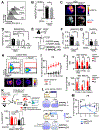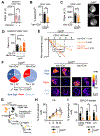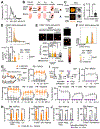A mitochondrial NADPH-cholesterol axis regulates extracellular vesicle biogenesis to support hematopoietic stem cell fate
- PMID: 38458178
- PMCID: PMC10957094
- DOI: 10.1016/j.stem.2024.02.004
A mitochondrial NADPH-cholesterol axis regulates extracellular vesicle biogenesis to support hematopoietic stem cell fate
Abstract
Mitochondrial fatty acid oxidation (FAO) is essential for hematopoietic stem cell (HSC) self-renewal; however, the mechanism by which mitochondrial metabolism controls HSC fate remains unknown. Here, we show that within the hematopoietic lineage, HSCs have the largest mitochondrial NADPH pools, which are required for proper HSC cell fate and homeostasis. Bioinformatic analysis of the HSC transcriptome, biochemical assays, and genetic inactivation of FAO all indicate that FAO-generated NADPH fuels cholesterol synthesis in HSCs. Interference with FAO disturbs the segregation of mitochondrial NADPH toward corresponding daughter cells upon single HSC division. Importantly, we have found that the FAO-NADPH-cholesterol axis drives extracellular vesicle (EV) biogenesis and release in HSCs, while inhibition of EV signaling impairs HSC self-renewal. These data reveal the existence of a mitochondrial NADPH-cholesterol axis for EV biogenesis that is required for hematopoietic homeostasis and highlight the non-stochastic nature of HSC fate determination.
Keywords: HSC self-renewal; NADPH; cholesterol; exosomes; extracellular vesicles; fate determination; fatty acid oxidation; hematopoietic stem cell; metabolism; mitochondria.
Copyright © 2024 The Author(s). Published by Elsevier Inc. All rights reserved.
Conflict of interest statement
Declaration of interests T.F. is a founder and equity holder in Generian Pharmaceuticals and Coloma Therapeutics. D.T.S. is a director and equity holder of Agios Pharmaceuticals, Magenta Therapeutics, Editas Medicines, Clear Creek Bio, and LifeVaultBio; he is a founder of Fate Therapeutics and Magenta Therapeutics and a consultant to FOG Pharma, VcanBio, and Flagship Pioneering.
Figures






Similar articles
-
Metabolism and HSC fate: what NADPH is made for.Trends Cell Biol. 2024 Jul 24:S0962-8924(24)00141-7. doi: 10.1016/j.tcb.2024.07.003. Online ahead of print. Trends Cell Biol. 2024. PMID: 39054107 Review.
-
Mitochondrial calcium homeostasis in hematopoietic stem cell: Molecular regulation of quiescence, function, and differentiation.Int Rev Cell Mol Biol. 2021;362:111-140. doi: 10.1016/bs.ircmb.2021.05.003. Epub 2021 Jun 21. Int Rev Cell Mol Biol. 2021. PMID: 34253293 Review.
-
Metabolism as master of hematopoietic stem cell fate.Int J Hematol. 2019 Jan;109(1):18-27. doi: 10.1007/s12185-018-2534-z. Epub 2018 Sep 15. Int J Hematol. 2019. PMID: 30219988 Free PMC article. Review.
-
Uhrf1 controls the self-renewal versus differentiation of hematopoietic stem cells by epigenetically regulating the cell-division modes.Proc Natl Acad Sci U S A. 2017 Jan 10;114(2):E142-E151. doi: 10.1073/pnas.1612967114. Epub 2016 Dec 12. Proc Natl Acad Sci U S A. 2017. PMID: 27956603 Free PMC article.
-
Hoxb5 defines the heterogeneity of self-renewal capacity in the hematopoietic stem cell compartment.Biochem Biophys Res Commun. 2021 Feb 5;539:34-41. doi: 10.1016/j.bbrc.2020.12.077. Epub 2021 Jan 5. Biochem Biophys Res Commun. 2021. PMID: 33418191
Cited by
-
Differentiation latency, cell division symmetry, and dormancy signatures define fetal liver HSCs at single cell resolution.bioRxiv [Preprint]. 2025 May 2:2023.06.01.543314. doi: 10.1101/2023.06.01.543314. bioRxiv. 2025. PMID: 37333272 Free PMC article. Preprint.
-
Feasibility and Safety of Targeting Mitochondria Function and Metabolism in Acute Myeloid Leukemia.Curr Pharmacol Rep. 2024 Dec;10(6):388-404. doi: 10.1007/s40495-024-00378-8. Epub 2024 Oct 4. Curr Pharmacol Rep. 2024. PMID: 40756330 Free PMC article.
-
CD63, a new therapeutical candidate for cholesterol homeostasis regulation through extracellular vesicles?Extracell Vesicles Circ Nucl Acids. 2025 Mar 19;6(1):166-170. doi: 10.20517/evcna.2024.92. eCollection 2025. Extracell Vesicles Circ Nucl Acids. 2025. PMID: 40206806 Free PMC article.
-
Emerging roles for fatty acid oxidation in cancer.Genes Dis. 2024 Dec 20;12(4):101491. doi: 10.1016/j.gendis.2024.101491. eCollection 2025 Jul. Genes Dis. 2024. PMID: 40290117 Free PMC article. Review.
-
Extracellular Vesicles & Co.: scaring immune cells in the TME since ever.Front Immunol. 2024 Aug 29;15:1451003. doi: 10.3389/fimmu.2024.1451003. eCollection 2024. Front Immunol. 2024. PMID: 39267748 Free PMC article. Review.
References
Publication types
MeSH terms
Substances
Grants and funding
LinkOut - more resources
Full Text Sources
Medical
Molecular Biology Databases
Research Materials

